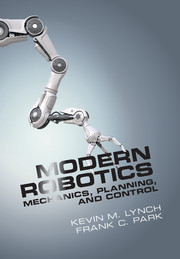Book contents
- Frontmatter
- Contents
- Foreword by Roger Brockett
- Foreword by Matthew Mason
- Preface
- 1 Preview
- 2 Configuration Space
- 3 Rigid-Body Motions
- 4 Forward Kinematics
- 5 Velocity Kinematics and Statics
- 6 Inverse Kinematics
- 7 Kinematics of Closed Chains
- 8 Dynamics of Open Chains
- 9 Trajectory Generation
- 10 Motion Planning
- 11 Robot Control
- 12 Grasping and Manipulation
- 13 Wheeled Mobile Robots
- A Summary of Useful Formulas
- B Other Representations of Rotations
- C Denavit–Hartenberg Parameters
- D Optimization and Lagrange Multipliers
- Bibliography
- Index
9 - Trajectory Generation
Published online by Cambridge University Press: 04 June 2024
- Frontmatter
- Contents
- Foreword by Roger Brockett
- Foreword by Matthew Mason
- Preface
- 1 Preview
- 2 Configuration Space
- 3 Rigid-Body Motions
- 4 Forward Kinematics
- 5 Velocity Kinematics and Statics
- 6 Inverse Kinematics
- 7 Kinematics of Closed Chains
- 8 Dynamics of Open Chains
- 9 Trajectory Generation
- 10 Motion Planning
- 11 Robot Control
- 12 Grasping and Manipulation
- 13 Wheeled Mobile Robots
- A Summary of Useful Formulas
- B Other Representations of Rotations
- C Denavit–Hartenberg Parameters
- D Optimization and Lagrange Multipliers
- Bibliography
- Index
Summary
During robot motion, the robot controller is provided with a steady stream of goal positions and velocities to track. This specification of the robot position as a function of time is called a trajectory. In some cases, the trajectory is completely specified by the task – for example, the end-effector may be required to track a known moving object. In other cases, as when the task is simply to move from one position to another in a given time, we have freedom to design the trajectory to meet these constraints. This is the domain of trajectory planning. The trajectory should be a sufficiently smooth function of time, and it should respect any given limits on joint velocities, accelerations, or torques.
In this chapter we consider a trajectory as the combination of a path, a purely geometric description of the sequence of configurations achieved by the robot, and a time scaling, which specifies the times when those configurations are reached. We consider three cases: point-to-point straight-line trajectories in both joint space and task space; trajectories passing through a sequence of timed via points; and minimum-time trajectories along specified paths taking actuator limits into consideration. Finding paths that avoid obstacles is left to Chapter 10.
Definitions
A path θ(s) maps a scalar path parameter s, assumed to be 0 at the start of the path and 1 at the end, to a point in the robot's configuration space _, θ : [0, 1] → _. As s increases from 0 to 1, the robot moves along the path. Sometimes s is taken to be time and is allowed to vary from time s = 0 to the total motion time s = T , but it is often useful to separate the role of the geometric path parameter s from the time parameter t. A time scaling s(t) assigns a value s to each time t ϵ [0, T ], s : [0, T ] → [0, 1].
Together, a path and a time scaling define a trajectory θ(s(t)), or θ(t) for short. Using the chain rule, the velocity and acceleration along the trajectory can be written as
- Type
- Chapter
- Information
- Modern RoboticsMechanics, Planning, and Control, pp. 282 - 305Publisher: Cambridge University PressPrint publication year: 2017

